Five Stock Watchlist: AI And Nuclear Stocks Lead This Week’s Trades

Image Source: Pexels
Five Stocks of the Week
Technology Stock of the Week: Teradyne (TER)
Teradyne stock is trading at new highs and set to move towards $200.
The company crushed third-quarter earnings and issuing bullish guidance for Q4 reporting EPS of $0.85, beating estimates by $0.06, with revenue of $769 million.That revenue was up 4.3% year-over-year and well ahead of consensus.
In addition, Management guided for Q4 sales growth of 25% sequentially and 27% year-over-year, signaling accelerating demand into year-end.
As a key supplier of semiconductor test and automation equipment, Teradyne’s results offer a real-time read on the health of the chip sector. The company’s SoC and memory test systems are used by nearly every major chipmaker, and the latest surge in orders underscores the strength of AI-related hardware demand.
The stock has cleared major resistance at $150 and pierced the upper Bollinger Band for the first time since June, confirming renewed momentum. A recent Golden Cross - where the 50-day moving average rose above the 200-day - adds further confirmation of a sustained bullish phase.
Bottom Line: Teradyne’s results confirm that AI hardware expansion is broadening beyond chip design into the entire testing and equipment ecosystem. Short-term traders can target $200 within 4–6 weeks, while long-term investors should view $250 as the next major objective as TER transitions from laggard to sector leader.
(Click on image to enlarge)
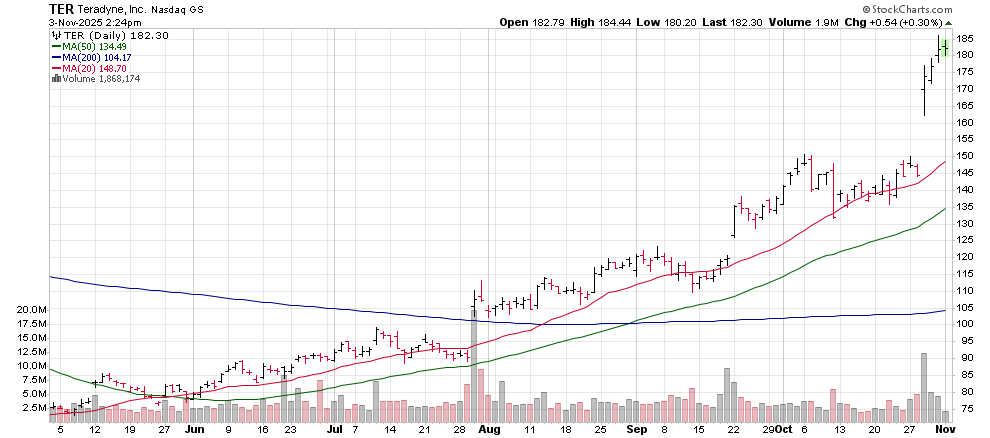
Growth Stock of the Week: Cameco (CCJ)
Cameco (CCJ) surged nearly 20% last week, but you’re about to get a chance to “buy the dip.”
Cameco announced a landmark partnership between Westinghouse Electric, Brookfield (BAM), and the U.S. Government to accelerate nuclear power development under the President’s May 2025 executive orders.
The agreement commits at least $80 billion toward new domestic reactors built with Westinghouse technology, marking nuclear power’s return as a central pillar of U.S. industrial, clean energy, and AI infrastructure policy.
Under the terms, Washington gains a 20% participation right in distributions beyond $17.5 billion and potential equity conversion if Westinghouse exceeds a $30 billion valuation by 2029.
For investors, the move validates the long-term nuclear bull market. It signals that Washington is now fully backing private-sector leaders like Cameco - the world’s largest uranium producer - to secure the fuel base for America’s AI and energy future.
The surge in AI-driven data center demand is fueling the shift: only nuclear offers scalable, carbon-free, baseload power to support it.
Technically, CCJ’s breakout above round-number resistance at $100 confirms powerful bullish momentum, though near-term consolidation is likely as traders lock in profits. The current pullback toward $100 should be viewed as a healthy setup within a broader long-term uptrend.
Cameco reports earnings November 5, and analysts - currently averaging a $91 price target - are expected to raise targets well above $100, potentially triggering the next leg higher for the nuclear trade.
Cameco remains in a long-term bull market rally with a target price of $150.
(Click on image to enlarge)
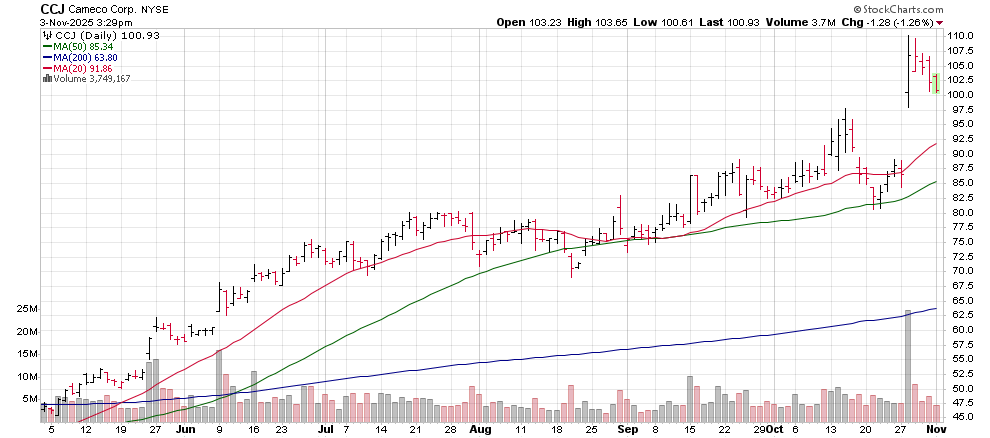
Stock Under $10 of the Week: MindMeds (MNMD)
Shares of MindMed (MNMD) dropped more than 12% Monday after the company announced a capital raise late Friday, just two minutes before the closing bell.
The firm priced $18.38 million common shares at $12.25 each, a level that acted as a magnet for trading throughout the session as investors recalibrated to the new valuation.
While the timing caught some traders off guard, the move itself is perfectly normal. MindMed stock had rallied more than 60% over the past two months, making a secondary offering both predictable and healthy for long-term shareholders. Raising capital following a major rally often signals management confidence in future growth and the need to fund ongoing trials and expansion.
The company reports earnings this Thursday after the close, with Wall Street expecting a loss per share of roughly $0.50–$0.52. Still, sentiment remains constructive following positive developments in its FDA clinical process and supportive comments from the White House on psychedelic-assisted therapy research.
Technically, MNMD continues to trade within a bullish uptrend despite the short-term volatility. The $12.50 level serves as strong support, while upside targets remain near $20, representing a potential 60% rebound from current levels.
Bottom line: This selloff looks more like a consolidation phase within a sustained breakout pattern, not the end of the trend.
(Click on image to enlarge)
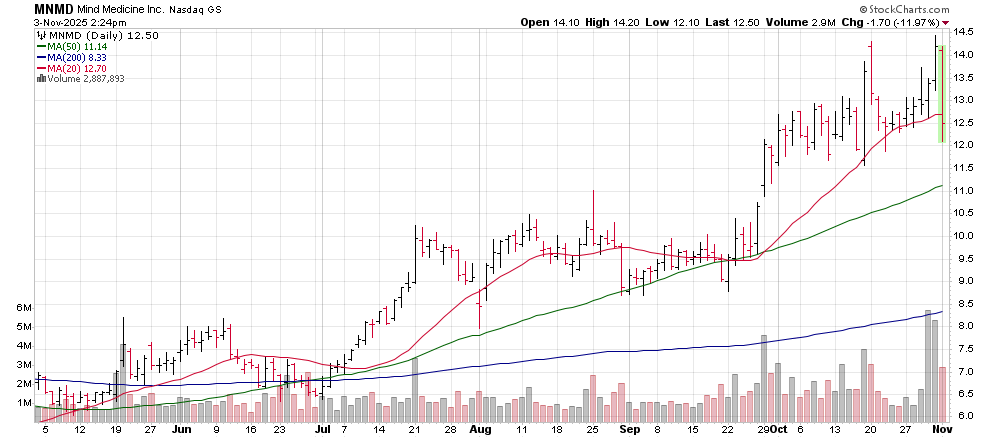
Income Stock of the Week: Once again….
Let’s speak openly… the “normal” filters are turning up names in the dividend yielding world, but all the resulting stock are heading into short-term bearish trends. At this moment in time – with the dividend market rolling over – it just isn’t worth trying to catch falling knives like AT&T (T) and Philip Morris (PM).
That makes this week’s income pick is simple and safe, again: the iShares 0–3 Month Treasury Bond ETF (SGOV). With a yield of 5.18%, SGOV offers a low-risk way to generate income on sidelined cash without tying up capital in longer-duration investments.
SGOV invests exclusively in U.S. Treasury securities with maturities of zero to three months, making it one of the most liquid and stable fixed-income options on the market. Its focus on ultra-short-term Treasuries means it carries minimal interest rate risk, insulating investors from the volatility that typically impacts longer-duration bond funds.
Because of this, SGOV is ideal for risk-averse investors or those seeking a temporary cash management vehicle while remaining in the market. While the yield is lower than longer-term bonds, it offers a more productive alternative to idle cash—especially in today’s rate environment.
Overall, SGOV is a tactical tool for capital preservation and short-term income generation, making it a smart choice for conservative portfolios or investors waiting for a better entry point into equities.
(Click on image to enlarge)
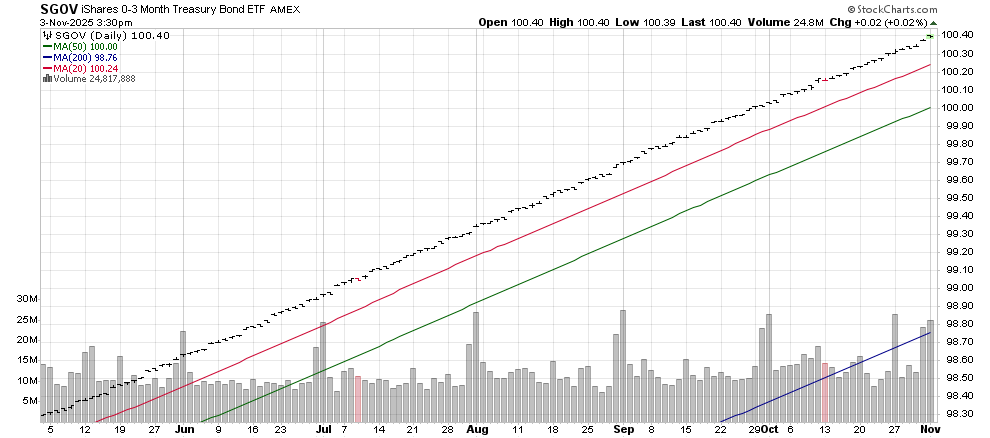
Bearish Stock of the Week: Home Depot (HD)
Home Depot (HD) shares are under renewed pressure as cracks in consumer spending begin to widen heading into the holiday season. Inflation expectations are rising again, and both the Federal Reserve and Wall Street analysts are warning that discretionary demand is softening. A cooling housing market is adding to the drag — with fewer homeowners preparing for spring listings, home improvement spending is slowing sharply.
Technically, Home Depot has shifted into a short-term bearish trend after the stock’s 50-day moving average rolled over into a descending pattern last week. That signals fading momentum after months of range-bound trading. The stock is now sitting directly on its 200-day moving average, a line that often acts as the final layer of intermediate-term support. A decisive break below this level would trigger a deeper correction.
More concerning is the test of the 20-month moving average near $370, a long-term trendline that has defined the stock’s bull market since 2022. A close below it would officially confirm a long-term bear market trend — Home Depot’s first in nearly three years.
With consumer spending cooling and housing activity stalling, downside risks are rising.
If HD fails to hold support, traders should target a move toward $300, where the next significant technical base sits. Until then, the path of least resistance is lower until evidence of renewed consumer strength emerges.
Target a move to $300.
(Click on image to enlarge)
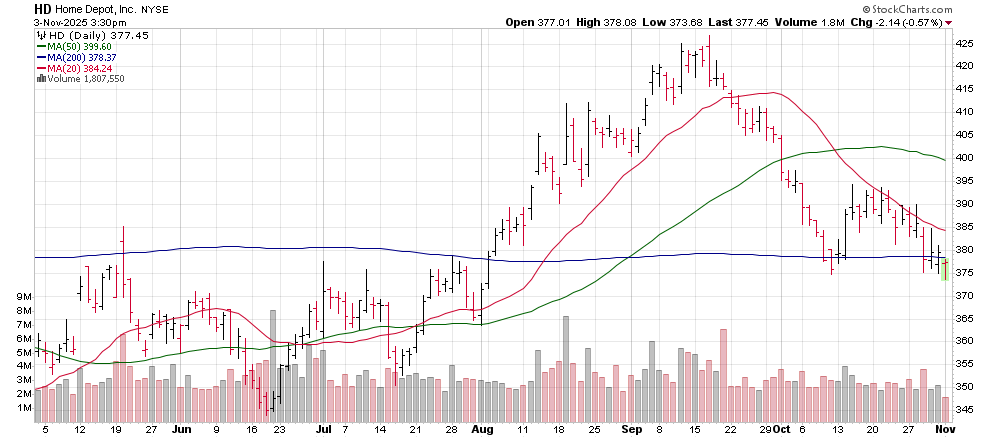
More By This Author:
This Is Where Rare Earth Stock UUUU Is A Strong BuyTaiwan Semiconductor Still Has Room To Run — And The Math Shows Where
Micron Technology Is Up Big This Year But It May Have Hit A Temporary Stall Point



